Anybody new to soft plastic fishing may find choosing which plastic to use on any particular fish species a little daunting.
In the last few years there has been a surge in popularity with plastic lures, and tackle shop walls have become lined with all different varieties of soft plastics.
In this article I am hoping to clear up any confusion regarding choice of plastic, size of jighead and which style of plastic is right for the job.
Using soft plastics to target trout can be very productive and can sometimes be the only way the lure angler can temp a trout into a strike when all else is fails.
I find the smaller, more natural shaped soft plastics to be the best for trout, especially in the natural dark colours. As most good fly fishers already know, many of the insects we see hovering above the water begin their lives under water either in the rocks or aquatic vegetation. At this stage of their lives they are called nymphs. For example, a mudeye is the nymph stage of a dragonfly.
For this reason I like to use very small soft plastics of around 1” in length in natural colours for trout, which may mimic a small nymph of some kind. I also like to rig it with a very light finesse jighead to allow the plastic to sink very slowly through the water column, giving the trout time to take the natural looking soft plastic.
This slow sinking and slow retrieving technique is particular handy in times of high fishing pressure when trout can become wary and shy, and reluctant to strike at any other foreign un-natural presentations.
Bladed spinners, bright coloured soft plastics and other un-natural looking presentations will certainly work well on trout in both lakes and streams at the right time, however the more natural presentation of the smaller dark slowly worked soft plastics will work more often and will often come into their own when the trout are flighty.
Redfin or English perch are the number one targeted species by many soft plastic freshwater anglers, including myself. In complete contrast to trout, which can be very shy and picky, and prefer a natural presentation, redfin love a slightly larger, vibrantly coloured soft plastic with a bit of attitude about it. I love using curl tail grubs of around 3” in length, preferably brightly coloured.
Redfin are a very inquisitive fish that strike at most things, however they do show a preference for bright colours, shiny metals and pretty much anything with a bit of red on it, as they are a very cannibalistic fish.
In the past, many of us have had great success targeting redfin with big bladed spinners like the good old Hogback or Ondex spinner. These spinners both had a bit of red fur on their treble hooks. Another very popular way of catching redfin for anglers in boats was by using heavy lead jagger’s which you would allow to sink, then with sharp lifting motions lift a foot or two off the bottom. The redfin would come over to the jagger to see what the fuss was about, quite often striking it. If they didn’t strike it, quite often they got hooked in the stomach or tail while they were swimming close to it.
Those older styles of redfin fishing still work very well, but with the advent of soft plastics redfin fishing takes on a whole new dimension. I like to use a heavy jighead, preferably vibrantly coloured, with a bright coloured plastic of around 3” (75mm) long, usually a grub shaped plastic. From the bank, or a boat, I like to cast out as far as I can, let the plastic sink to the bottom, and then very slowly retrieve the plastic.
As I retrieve, it starts coming up off the bottom, so every few metres I pause to let it sink again, before slowly starting to retrieve it again. The 3” curl tail grubs are perfect for this technique because their tail wiggles violently under water with the slightest of retrieve, allowing for very slow retrieve speeds, keeping the plastic in the strike zone for longer. This technique is dynamite for redfin, especially with bright vibrant soft plastics and jigheads. I really can’t push the message of using bright colours for redfin enough.
Another soft plastic technique to employ when fishing from a boat or kayak which works particularly well in snaggy areas, is to just lower the plastic down directly beside the boat, similar to the old jagging technique. Once the plastic hits the bottom, bob it up and down to keep it moving.
Don’t jag it straight up with a powerful motion, just gently bob it 50-100mm off the bottom to keep it moving and keep that tail wriggling. The bright colours and movement will have the redfin schooled up under the boat checking it out in no time.
When targeting golden perch most people overlook soft plastics and head straight for the lipless crankbaits, small spinnerbaits and small hardbodied lures. These lures are all very good, but there is certainly a place for soft plastics in the world of golden perch fishing.
I have caught plenty of golden perch in weedy lakes on soft plastics, such as Lake Sambell and Lake Kerford in Beechworth. Lake Sambell in particular is heavily effected by ribbon weed, and trolling a hardbodied lure is limited to a very small section of the lake. Spinnerbaits work a bit better in the ribbon weed but still get fouled up quite a lot.
The way I overcome this problem is by switching to a soft plastic, which can be rigged weedless. You can actually buy weedless jigheads that can be rigged with the tip of the hook just slightly penetrating the plastic, keeping the tip of the hook buried. It’s quite amazing when you first cast into a heavily weeded are rigged like this, you can feel the plastic getting wedged in between the weeds, and feel the force and weight of the weed, but then as soon as the plastic breaks free of the weed it works perfectly and when you reel it in there is no weed on the hook!! The force from a striking fish will break the plastic free of the hook tip allowing for the fish to hook up.
Weedy areas are one place where soft plastics are a better option for golden perch, other places are high snag areas, such as irrigation channels below spillways where you lose a lot of lures getting snagged on rocks in the fast current, and popular access points where anglers fishing from the bank with bait often get snagged and snap there line. Obviously there are snags in these areas, and also a lot of line for you to get snagged on, or tangled in which can cost a lot of money in lost fishing tackle.
Soft plastics are an excellent option for chasing golden perch in these areas as they are much more expendable. A packet of 3” or 4” curl tail grubs is usually under $10 and a packet of jigheads is usually around the $6-$8 mark sometimes cheaper, making a single soft plastic rig around $1.50 on average. Losing a $1.50 plastic to a snag is much easier to handle than losing a $15 hardbodied lure!!
For golden perch I like a 3” or 4” curl tail grub or some kind of paddle tail plastic of similar size with a reasonably heavy jighead of around 6-7g. I prefer dark colours for golden perch, especially a dark purple. I have caught them on white soft plastics as well, but dark colours seem to have been more consistent for me.
Catching Murray cod on soft plastics is more of a sport than anything else. It is another challenge, and may buy you a few more bragging rights, but it certainly is not as productive as other more conventional techniques in my opinion.
One of the things I like most about catching Murray cod on soft plastics is the powerful strike you receive when the fish hits the plastic! Because the plastic has very little or no resistance moving through the water, your rod tip is almost perfectly straight when the fish hits, making the powerful strike feel even more powerful than normal!
I like to use pre-rigged soft plastics for Murray cod, such as the large plastics of around 5-6” long with the weight already in them.
I fish them almost exactly the same as I fish a spinnerbait, just casting the plastic as close as possible to the likely looking areas, letting it sink and retrieving it slowly with a bit of a jerking motion to put a bit of movement into the plastic.
In clear water I like a really dark, naturally presenting soft plastic, and in the cloudier water I like something a little lighter in colour, like a white or pink colour. If the water clarity is poor, I would not bother with a soft plastic and would revert back to something with a rattle, or a blade to send vibrations through the water.
The soft plastic craze seemed to slow a lot in recent seasons, but rest assured they are as effective as they have ever been.
For something different or to set yourself another challenge, give the plastics a go, I’m sure you will be very happy with the results.
Reads: 26425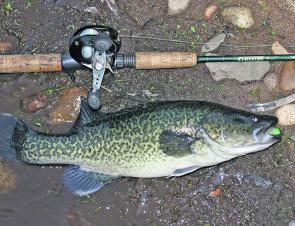
A Murray cod of around 40cm caught on a green coloured Tsunami soft plastic in clear water.
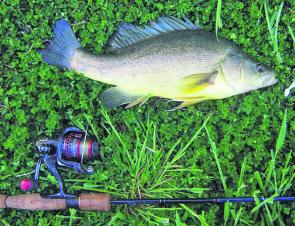
A nice golden perch caught on a small Squidgy wriggler as a by-catch while targeting redfin in a small lake.
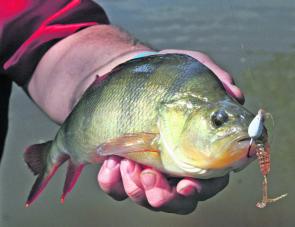
A chunky redfin caught on a Damiki D grub rigged on a title shot weedless jig head.

A rainbow trout taken on the deadly black Strike Tiger 1” nymph soft plastic in the Ovens River during the last Christmas break when the fish were very flighty.

A large redfin on a vibrantly coloured Strike Tiger 3” curl tail grub and Knuckleball jighead combination. When targeting redfin with soft plastics, don’t be afraid to go over the top with bright colours.
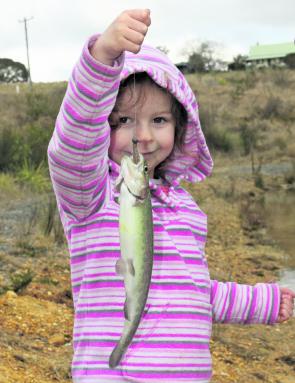
Skye Alexander with a lovely rainbow trout caught on a Damiki 2” air craw in a stocked family fishing dam. Small soft plastics always work well in these stocked waterways.
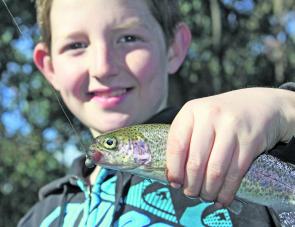
A lovely rainbow trout caught on a Damiki M grub in a stocked family fishing dam. Small soft plastics always work well in these stocked waterways.
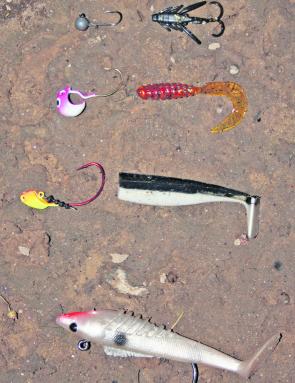
A range of soft plastics. From the top, A black 1” Strike Tiger nymph with a small Squidgy jig head, an ideal rig for trout. Second from the top, A red Damiki curl tail grub with a vibrantly coloured Knuckleball jighead, a great rig for redfin. Third from

A beautifully coloured brown trout that fell to the reliable Strike Tiger 1” nymph in the Ovens River during a period of high fishing pressure.
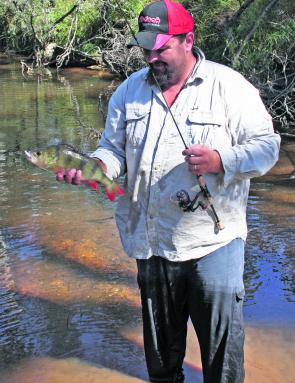
A decent small stream redfin caught on a Strike Tiger 3” curl tail grub in whitebait pearl colour.
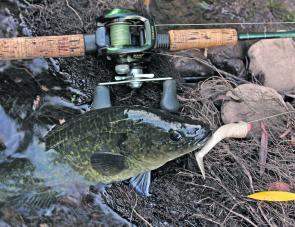
A young Murray cod caught on a Squidgy Slick Rig in drop bear colour.




